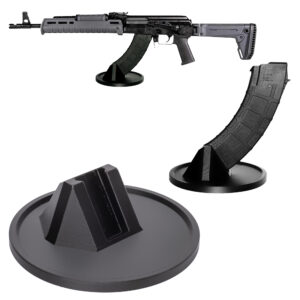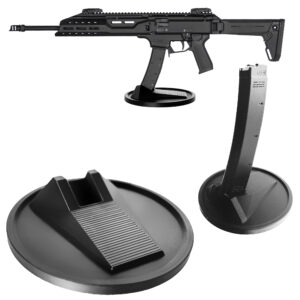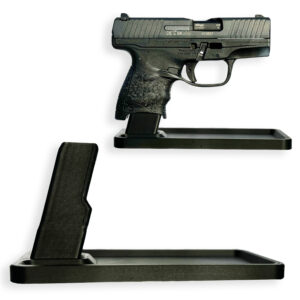Categories:
The AR-15 is a versatile and highly customizable rifle platform, integral to the American guns landscape. One of its key components, the charging handle, plays a critical role in the operation of the rifle, particularly in manually cycling the bolt carrier group (BCG). This seemingly simple piece of equipment is essential for the proper functioning, safety, and maintenance of the AR-15.
The charging handle is located at the rear of the upper receiver and serves multiple purposes. Primarily, it is used to manually cycle the bolt carrier group, which in turn chambers rounds, clears jams, and aids in routine maintenance. When the handle is pulled to the rear, it engages the bolt carrier and withdraws it, moving the bolt and allowing for the insertion of a cartridge into the chamber.
Releasing the handle allows the bolt carrier group to move forward under the pressure of the recoil spring, thereby chambering a new round and making the rifle ready to fire. This sequence is crucial for the initial loading and any subsequent manual operations that might be necessary. In addition to loading and chambering, the AR-15 charging handle is indispensable for clearing malfunctions.
In scenarios where spent casings or misfired rounds cause a stoppage, pulling back the charging handle ejects the obstructing brass and allows the user to attempt feeding a new round. This makes the charging handle a crucial tool during malfunction drills and ensures the shooter can quickly return to action. Furthermore, the charging handle has evolved over the years with various designs and enhancements that cater to different shooting needs.
Ambidextrous models, for instance, allow both right- and left-handed shooters to operate the handle with ease. Extended latch versions provide a larger gripping surface, which can be particularly useful when manipulating the handle with gloves or under stress. The charging handle also plays a role in the maintenance and disassembly of the AR-15. Removing the charging handle is necessary to take out the bolt carrier group for cleaning or inspection.
Regular maintenance is critical to ensure reliability and longevity, making the charging handle an essential component for any AR-15 owner.
The charging handle is a critical component in the AR-15 rifle, particularly when it comes to manually cycling the bolt carrier group (BCG). Its importance cannot be overstated as it plays a vital role in the functionality and reliability of the gun. In essence, the charging handle allows the shooter to pull the bolt carrier group to the rear, thereby initiating the process of loading a round into the chamber.
This is the same handle that is used to clear malfunctions, chamber the initial round, and check the condition of the chamber, among other tasks.
The act of manually pulling the charging handle to the rear engages the bolt carrier group, extracting any spent cartridges and loading a fresh round from the magazine into the chamber, readying the gun for the next shot. This manual cycling of the BCG is essential, especially in situations where the gun may have failed to cycle correctly on its own, such as after a misfire or during a malfunction.
By operating the charging handle, the shooter gains control over the action of the gun, ensuring that it is in the proper state to perform as needed.
Moreover, the charging handle serves as a diagnostic tool. When experiencing a stoppage or malfunction, the shooter can use the charging handle to inspect the chamber and diagnose the issue. This quick and efficient method helps in identifying simple problems that can be rectified immediately, such as a failure to eject or a double feed. This ability to clear malfunctions manually is crucial in both tactical scenarios and recreational shooting, where reliability and readiness are paramount.
In addition, the charging handle is pivotal in the initial loading of the gun. When a new magazine is inserted, pulling the charging handle to the rear and then releasing it enables the bolt carrier group to strip a round from the magazine and chamber it, making the gun ready for use. This action sets the gun into a ready state, which is essential for immediate response, be it in a defensive scenario or in competitive shooting.
Ultimately, the charging handle’s role in manually cycling the bolt carrier group underscores its indispensable function in maintaining the operational readiness and reliability of the AR-15 platform.
The AR-15 charging handle is a crucial component designed to manually cycle the bolt carrier group, ensuring that the gun is operational and can be cleared or maintained efficiently. Built with functionality in mind, it integrates several key parts and components that contribute to its overall performance and reliability. Primarily constructed from high-quality aluminum or steel, the charging handle is designed to withstand the rigors of repeated use and the mechanical stress of pulling and releasing.
The primary section of the charging handle, known as the latch, protrudes externally for ease of grip and manipulation. This latch typically includes a spring mechanism that ensures it remains securely in place when not in use, preventing any unintended movement that could compromise the gun’s operation. Central to the charging handle’s functionality is the latch pin, a small but mighty component that attaches the latch to the handle body and allows it to pivot.
This pivoting action is essential for disengaging the bolt from its forward position and enabling it to cycle rearward. The construction of the latch pin is equally robust, often crafted from hardened steel to resist wear over time. The actual handle or grip portion is ergonomically designed for a comfortable and secure hold. It may feature texturing or knurling to prevent slippage, even in adverse conditions where hands might be wet or gloved.
Some advanced models also include ambidextrous designs or extended latches to cater to a wider variety of users and usage scenarios. Internally, the charging handle interfaces with the carrier key of the bolt carrier group. When pulled rearward, this interface allows the bolt carrier group to retract, chambering a round or clearing the chamber. During this movement, ensuring a smooth and reliable action is paramount, so the sections of the charging handle that make contact with other internal parts are often finely machined to reduce friction and wear.
Additional attention may be given to the coating of the charging handle, with common finishes including anodized aluminum or other corrosion-resistant treatments. These coatings not only enhance the durability of the charging handle but also ensure a smooth and consistent operation.
The charging handle is an essential component of the AR-15 platform, serving a critical role in the manual cycling of the bolt carrier group (BCG). When an operator pulls the charging handle, it interfaces directly with the bolt carrier group to facilitate several key functions: chambering a round, ejecting a spent cartridge, and clearing malfunctions.
An AR-15’s charging handle is mounted at the rear of the upper receiver, and upon being pulled back, it directly engages with a protrusion or “ear” on the bolt carrier. This engagement is mechanical and relies on the precision engineering of both the charging handle and the bolt carrier group to ensure smooth and reliable operation.
As the charging handle is pulled rearward, it forces the bolt carrier group to travel along the receiver rails towards the buffer tube, compressing the buffer spring. This rearward movement causes the bolt to unlock from the barrel extension and retract, which if there is a spent cartridge in the chamber, will be extracted and ejected through the ejection port. The full retraction of the BCG is essential for ensuring the proper ejection of casings and clearing of the chamber.
Upon release, the tension in the buffer spring propels the bolt carrier group forward. This forward motion is guided by the charging handle until the BCG is fully seated. As the bolt carrier group moves forward, it strips a new round from the magazine and chambers it, while the bolt itself rotates and locks into the barrel extension, preparing the gun to fire the next round.
The interface between the charging handle and the bolt carrier group must be both robust and smooth-operating to maintain the AR-15’s reliability. Any irregularities or malfunctions in this process could result in failures to feed, fire, or eject, which could compromise the gun’s operational readiness. Thus, maintaining and periodically inspecting both the charging handle and the bolt carrier group is vital for ensuring the weapon functions flawlessly under various conditions.
The seamless interaction between these components exemplifies the ingenious engineering behind the AR-15’s design, making it a highly effective gun for a wide range of applications.
To manually cycle the bolt carrier group using the charging handle on an AR-15, it is crucial to understand the function and mechanics involved, as this process plays a vital role in the gun’s operation. The charging handle is located at the rear of the upper receiver and serves as the mechanism by which the shooter manually manipulates the bolt carrier group (BCG).
Initially, ensure that the gun is pointed in a safe direction and your finger is off the trigger. Visually and physically inspect the chamber and magazine to confirm the weapon is unloaded. If the rifle has a dust cover, flip it open to access the charging handle. Using your thumb and index finger, grasp the latch on the left side of the charging handle and simultaneously pull the handle rearward.
This action disengages the charging handle from its locked position in the upper receiver.
As you continue pulling the charging handle back, the bolt carrier group is also pulled rearward, compressing the buffer spring located in the buffer tube. This movement extracts any cartridge or casing from the chamber and prepares the gun for the next step. Once the charging handle and bolt carrier group reach their rearmost positions, you may notice that the bolt catch can engage automatically if the magazine follower activates it, holding the bolt open.
If you wish to release the bolt carrier group, either press the bolt catch or push the charging handle slightly forward to disengage the catch. Allow the charging handle to move forward under the tension of the buffer spring, guiding it if necessary, until it returns to its original forward position, chambering a new round if the magazine is loaded.
Repeatedly cycling the bolt carrier group can aid in diagnosing malfunctions, clearing jams, or simply ensuring the proper function of the rifle. By mastering the charging handle’s operation, shooters can efficiently maintain control over their AR-15 and resolve issues swiftly.
The AR-15 charging handle is a critical component that allows the user to manually cycle the bolt carrier group, facilitating loading, unloading, and clearing malfunctions. Proper maintenance and troubleshooting of the charging handle are essential for optimal performance and longevity of the gun.
To maintain the charging handle, regular cleaning is paramount. After each shooting session, ensure that the gun is unloaded and safe before commencing any maintenance activities. Remove the charging handle from the upper receiver by first separating the upper and lower receivers, then sliding the charging handle and bolt carrier group out. Using a soft brush and a mild solvent, clean all surfaces of the charging handle, paying special attention to the channels and latch mechanism where dirt and carbon buildup tend to accumulate.
Wipe it clean with a dry cloth and apply a light coat of lubricant to prevent rust and ensure smooth operation.
Regular inspection of the charging handle is equally important. Check for signs of wear or damage, particularly on the latch and the channels where the handle engages with the upper receiver. Over time, excessive wear can cause the charging handle to become loose or fail to engage properly. In such cases, replacement of the charging handle is advised to avoid functional issues during operation.
Troubleshooting a malfunctioning charging handle typically involves addressing issues related to sticking, difficulty in pulling, or failure to fully open. These problems can often be attributed to debris buildup, lack of lubrication, or bent or damaged components. Cleaning and lubricating the charging handle as described can resolve many minor issues. If the handle remains difficult to operate, inspect the upper receiver for alignment issues or obstructions that may be impeding the handle’s movement.
In some cases, the latch spring may weaken over time, resulting in a charging handle that does not stay securely in place. Replacing the latch spring is a relatively simple and inexpensive fix. Ensuring that all components are clean, well-lubricated, and in good working order will help maintain the charging handle’s functionality and reliability, contributing to the overall effectiveness of the AR-15.
Upgrading and customizing the AR-15 charging handle offers a range of benefits from improved functionality to enhanced ergonomics. The standard charging handle that comes with most AR-15 rifles can be sufficient for general use, but many shooters find that aftermarket options provide significant advantages. One popular customization is the ambidextrous charging handle. Designed to be operated easily from either side of the rifle, ambidextrous models are particularly valuable for left-handed shooters or for use in tactical situations where one might need to operate the rifle with either hand.
These handles often feature extended latch designs that make them easier to grasp and manipulate, even with gloved hands.
Another common upgrade is the oversized charging handle. These are designed with larger latches to provide a more substantial gripping surface. This is particularly useful in high-stress situations where dexterity may be compromised, or when one needs to quickly and efficiently charge the rifle. The larger surface area makes it simpler to grab and pull, providing the shooter with more confidence and control.
For those who frequently use optics, a charging handle with a gas buster feature might be worth considering. These handles are designed to redirect gas away from the shooter’s face, a useful feature for suppressor users or those who experience gas blowback issues due to their setup.
Material and build quality also play a crucial role in the performance of a charging handle. Options made from high-strength aluminum or even steel can provide added durability, which is beneficial for rifles that see heavy use. Some models also incorporate advanced coatings, such as hard coat anodizing or nickel-boron finishes, to reduce friction and wear, enhancing longevity and reliability.
Customization can extend to aesthetic preferences as well. Charging handles are available in various colors and finishes, allowing owners to personalize their rifles to match their stylistic preferences or to create a uniform look with other components. From improved ergonomics and operational efficiency to aesthetic upgrades, there are numerous ways to enhance the performance and look of an AR-15 through charging handle upgrades.








Colt
Colt M4 Carbine
Colt LE6920
Colt AR-15 A4
Daniel Defense
DDM4 V7
DDM4 V9
DDM4 V11
DDM4 ISR (Integrally Suppressed Rifle)
Smith & Wesson (S&W)
M&P15 Sport II
M&P15 Tactical
M&P15T
Bravo Company Manufacturing (BCM)
BCM Recce-16
BCM Recce-14
BCM MCMR Series
Aero Precision
M4E1 Series
AC-15
AR15 Pistol (Various Configurations)
Ruger
Ruger AR-556
Ruger SR-556
Ruger AR-556 MPR (Multi-Purpose Rifle)
Springfield Armory
Saint Victor
Saint Edge
Saint AR-15
PSA (Palmetto State Armory)
PSA PA-15
PSA AR-V
PSA Jakl (AR Pistol)
FN America
FN 15 Tactical Carbine
FN 15 Patrol
FN 15 DMR
Wilson Combat
Recon Tactical
Super Sniper
Protector Carbine
SIG Sauer
SIG M400 Tread
SIG M400 Elite
SIG M400 SDI
LWRC International
IC DI (Direct Impingement)
IC SPR
IC A5
Bushmaster Guns
XM-15 QRC
Bushmaster MOE
XM-15 Patrolman
Rock River Arms
LAR-15 Entry Tactical
LAR-15 Predator
LAR-15 Elite Comp
Stag Arms
Stag 15 Tactical
Stag 15L (Left-Handed Models)
Stag 15 Valkyrie
Noveske Rifleworks
Noveske Gen 4 N4
Noveske Space Invader (AR Pistol)
Noveske Recon
Anderson Manufacturing
AM-15 Optic Ready
AM-15 M4 Carbine
AM-15 Precision Rifle
Adams Arms
AA-15 Piston Rifle
P2 AARS (Adams Arms Rifle Series)
Black Rain Ordnance
SPEC15 Series
BRO Predator
Fallout 15
Diamondback Guns
DB15 Series
DB15CCMLB
DB15EB
Del-Ton Inc.
DTI-15
Del-Ton Echo 316H
Sierra 316M
Windham Weaponry
Windham SRC
Windham VEX-SS
Windham RMCS-4 (Caliber Conversion System)
Christensen Arms
CA-15 G2
CA-15 Recon
CA-15 Titanium Edition
Patriot Ordnance Factory (POF-USA)
Renegade Plus
P415 Edge
Revolution DI
LaRue Tactical
PredatAR
OBR (Optimized Battle Rifle)
LaRue Stealth 2.0
Battle Arms Development
Workhorse Patrol Carbine
BAD556-LW (Lightweight)
Authority Elite Rifle
Faxon Guns
Ascent AR-15
FX-19 (AR Pistol)
Streamline Ultralight Series
KE Arms
KE-15 SLT (Super Lightweight Tactical)
KE-15 Scout Carbine
Primary Weapons Systems (PWS)
MK1 MOD 2-M
MK116 PRO
MK107 (Piston AR Pistol)
ZEV Technologies
ZEV Core Elite Rifle
ZEV AR15 Billet Rifles
Franklin Armory
BFSIII AR-C1
Militia Model
F17-L (Chambered in .17 WSM)
Seekins Precision
SP15 DMR
NX15 Skeletonized Rifle
Havak Bravo
Aero Precision (Additional Models)
EPC-9 (Pistol Caliber ARs)
VG6 AR Rifles
Barrett Guns
REC7 DI
REC7 Gen II
CMMG
MK4 RCE
Resolute 300
Banshee (AR Pistol)
DPMS Panther Arms
Panther Oracle
Panther LR-308
H&K (Heckler & Koch)
HK MR556A1
HK416 (Military Variant)
Rock Island Armory (Armscor)
VR-80 Tactical AR (Shotgun AR Platform)
Troy Industries
Troy SPC-A3
Troy PAR (Pump Action AR)
Wilson Tactical
Tactical Recon AR
Protector Series
F1 Guns
FDR-15 Skeletonized Rifle
BDRx-15 Series
Juggernaut Tactical
JT-15
JT-10 Precision Rifle
AeroSurplus
Surplus AR-15 Rifles (Budget Models)
Thunder Tactical
AR-15 Basic Carbine
Tactical Builder Sets
Radical Guns
RF-15
Forged AR-Series
Dark Storm Industries
DS-15 Featureless Rifles
DS-10 Typhoon
DRD Tactical
Paratus
Aptus AR Rifles
Bear Creek Arsenal
BCA-15
AR Complete Upper Builds
Aero Survival Rifles (ASI)
ASR Tactical Series
Tactical Edge
WARFIGHTER Series
AR-15 Lightweight Rifles
Lone Star Armory
TX15 DMR
TX15 Carbine
HERA Arms
HERA H7
HERA AR-15 Lower Builds
IWI (Israeli Weapon Industries)
Zion-15
DRD Tactical
Tactical Modular Rifles
Quick-Takedown Rifles
V Seven Weapons
1776 Rifle
Hyperlite Rifle
Core Rifle Systems
Core15 Tac III
Core15 Patrol Rifle
Armalite (Original AR-15 Creator)
M15 Tactical
M15 A4 Carbine
DEF15 (Defensive Sporting Rifle Series)
PSA (Palmetto State Armory Additional Models)
PSAK-47 Hybrid (AR-AK Style Hybrid)
PSA Dagger (Pistol Caliber Configurations)
Odin Works
OTR-15
Odin Recon Rifle
Maxim Defense
MDX-508 PDX (Compact AR Pistol)
MDX-510 Rifle